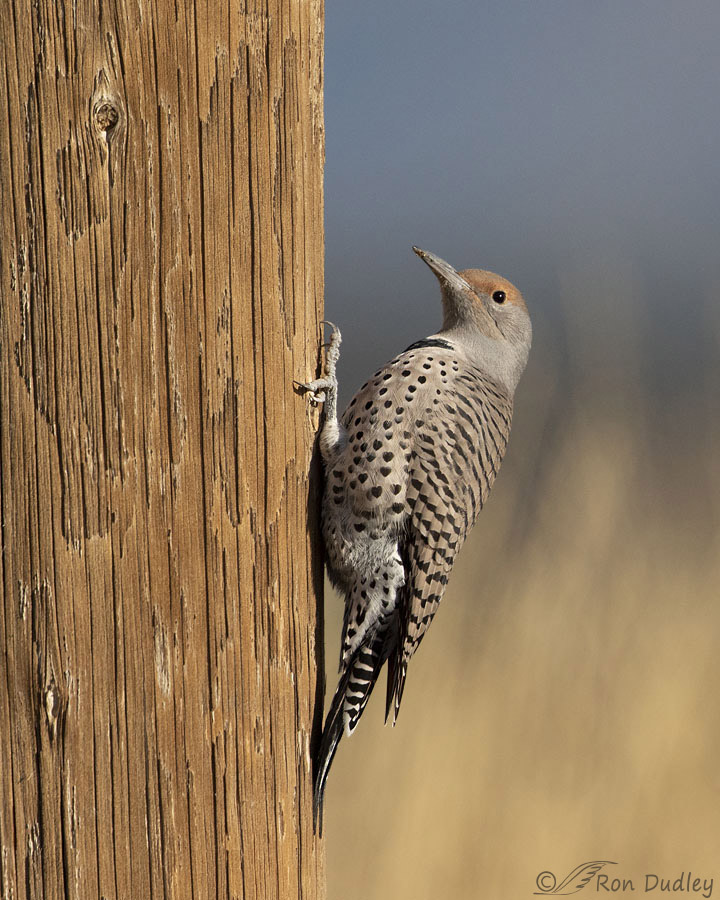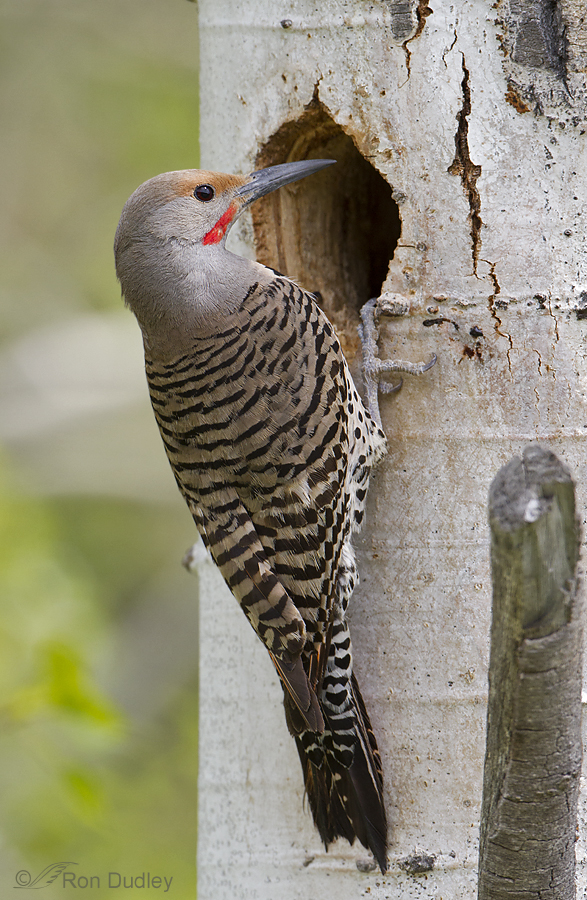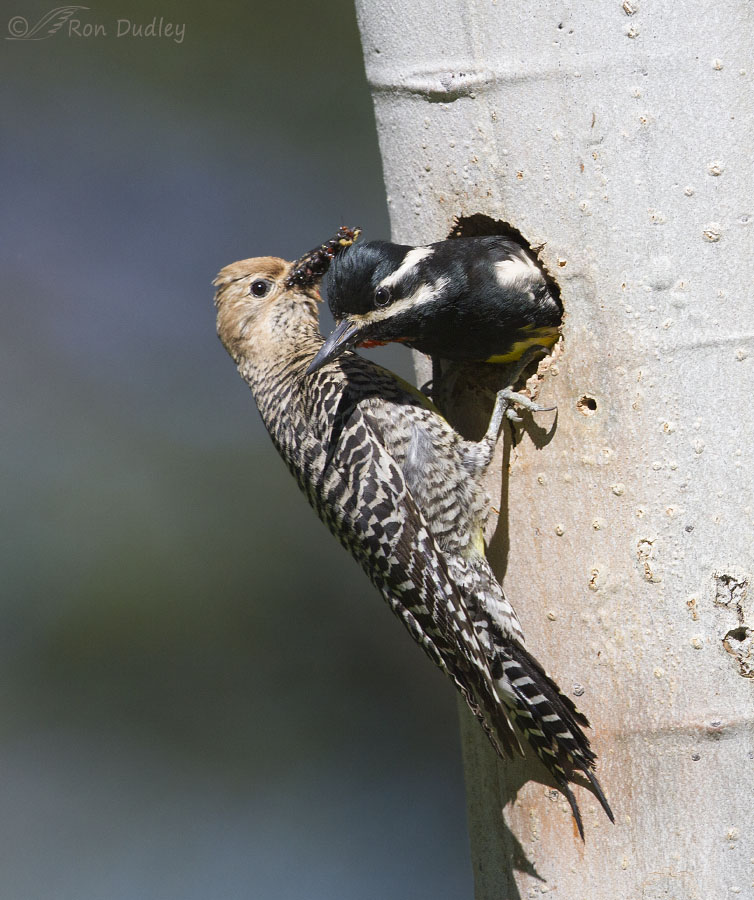Woodpeckers have a number of adaptations that allow them their unique lifestyles, including but not limited to the following:
- a thick-walled skull and cushioning absorbent tissue to help them withstand the physical shocks from their hammering head blows.
- an unusually long, barbed and sticky tongue supported by some unique anatomy to assist in extracting insects from crevices
- a bill that grows continually because of the wear it is subjected to from the incessant hammering
But they have other adaptations too and after my recent Northern Flicker blog post Dan Gleason emailed me to say (among other things) “Your final photo of the flicker is perfect for showing how a woodpeckers’ foot really works” and then he went on to explain some of the anatomy and biology involved. He also covered some of the interesting and unique properties of woodpecker tails since my flicker image illustrated that well too. I already knew most of the information Dan provided but not all of it and he pulled it all together cohesively for me. So with Dan’s permission, which he kindly provided, I’d like to relay some of what he told me in my own words as best I can.
When it comes to birds Dan knows his stuff. Among other qualifications he’s taught the Field Ornithology course in the Biology Department at the University of Oregon for years and he also teaches classes and workshops to the general public and gives public lectures around the state of Oregon. When Dan talks birds I sit up and pay attention.
- I’m not lying. There’s a male Northern Flicker calling just outside my window as I type this. All I have to do is turn my head to my left and I can see him. I think he’s telling me to get it right!
The first photo below of a Northern Flicker, a type of woodpecker, is the one Dan was referring to in his email to me.

Feet:
Depending on the lifestyle of the species birds have several different types of toe arrangements on their feet. Anisodactyl with three toes pointing forward and one toe pointing back is the most common and that’s the arrangement songbirds have. But woodpecker toes have an arrangement called zygodactyl with two toes pointing forward and two toes rotated rearward.
However when woodpeckers are clinging to vertical surfaces like trees, which they usually are, they don’t keep their rear toes pointing back, as you see in the photo above. Instead the outside lower toe (generally referred to as toe #4) is pointed out to the side and the inside lower toe (toe #1) which is of little use in this situation is tucked under the foot and toward the outside also.
About the only times woodpeckers keep their rear toes actually pointing back is when they wrap their feet around a horizontal branch or when they’re dead and sitting in a museum drawer. This is something even many field guides get wrong. If you check your Sibley Guide To Birds you’ll see that David Sibley drew his woodpeckers clinging vertically to trees with their rear toes pointing back (down), a completely unnatural toe position for most woodpeckers.
Tails:
When woodpeckers are clinging to vertical surfaces they have to use the ends of their tails as props for support. In this case their feet are essentially the fulcrum of a lever and the tail keeps the rigid body of the bird from tipping back too far. As we can see from the bent end of the tail in the photo above this puts significant pressure and resulting wear and tear on the tail. When I’m photographing woodpeckers at their nesting cavity entrances in trees I can actually see significant wear on the wood below the entrance where the woodpeckers have landed repeatedly at the entrance and used their tails as props in a particular spot. So you can imagine the wear and tear on the tail feathers responsible for the wood being worn.
But woodpeckers have a defense against tail feather wear.
Woodpeckers have completely black, or mostly black, tails. The darker feathers of birds owe their color to the pigment melanin which gives them greater mechanical strength so they’re more resistant to wear, bacterial degradation and parasite damage and less likely to break under pressure. The added toughness of black feathers is also important to species who migrate long distances like American White Pelicans, Western Tanagers, Black-headed Grosbeaks and many others whose primaries and secondaries are black.

Here’s another view of a different Northern Flicker showing the arrangement of their rear toes while perched vertically.

Sapsuckers are also types of woodpeckers. Here the female of a mated pair of Williamson’s Sapsuckers whose bill is loaded with ants for her chicks leans to the side to allow her mate to exit the nest cavity. Her lean allows us to see her toe arrangement well with one rear toe pointing to the outside and the other one folded in the same direction.
Notice the extended, stiff black shafts of the tail that give support without the vanes interfering or being quickly worn away.
Woodpeckers are fascinating and unique birds, so much so that many of Dan’s public presentations are about woodpeckers alone.
Thanks, Dan.
Ron


That is so interesting and informative. I’m heading straight over to my collection of woodpecker photos to see how many times I have overlooked their toe placement. Cuckoos are also zygodactyl– I wonder why and how it gave them a selective advantage.
As soon as I saw the term, “zygodactyl” I had a good laugh to myself. It immediately reminded me of the humorously educational “True Facts about the Owl”.
(1:29) “Its talons are zygodactyl – two in front, two in back.”
https://www.youtube.com/watch?v=XeFxdkaFzRA
Later on when I discovered Feathered Photography, I learned that when an owl bobs its head up and down to increase depth perception, it’s called “parallaxing”.
Amy, I’ll admit it. I’ve always been a fan of scientific terminology…
I’ll add another “fascinating!!!” to the mix! Soooo interesting to learn all this info about woodpeckers. Huge thanks to you and Dan! As usual when I get to learn something new, I’m grinning ear to ear.
And speaking of ear(worm)s…https://www.youtube.com/watch?v=RnpZpAPaLew (Sorry! Couldn’t resist. )
)
Marty, believe it or not I still associate the name Walter Lantz with that intro…
Fascinating… Thank you for the info.
Thanks, Krishna.
I feel like I’ve been to Woodpecker school and thoroughly enjoyed it. Ectropodactyly, thick skulls, black tails, oh my! (ectropodactyl, ectropodactyl, ectropodactyl…..)
You’d never learn this stuff on Jeopardy.
Thanks for an absolutely fascinating post.
“You’d never learn this stuff on Jeopardy”
Made me laugh, Lyle. Thanks.
The question concerning 3-toed woodpeckers: All species of 3-toed woodpeckers drill deep into the wood in search of insect larvae burrowed deeply. The lack of the first toe allows them to sit back just a bit more than other woodpeckers, giving the head a slightly longer distance to travel and hit with more force. There are other adaptations that allow for this harder impact as well. And there are certainly many deep-drilling woodpeckers that have all four toes, such as the Hairy Woodpecker. So many unique and wonderful adaptations in woodpeckers. One of my public presentations is an hour long talk just on woodpeckers and I still can’t cover all of their unique festures. Fascinating birds. (But then, I say that about all birds.)
Dan, A friend on Facebook asked the same question about Three-toed Woodpeckers so I copied and pasted what you said above to that conversation. Good timing!
We have Hairy Woodpeckers (as well as Downey) now I’ll have to pay more attention to toes!
How absolutely fascinating. Huge thanks to you and to Dan.
However is it just me? This woodpecker fact ‘a thick-walled skull and cushioning absorbent tissue to help them withstand the physical shocks from their hammering head blows.’ instantly made me think of one or more humans.
Not just you, EC. Thick-skulled humans are a dime a dozen these days and it’s getting worse.
Great lesson! You know how I love to learn, professor.
I do. Thanks, Arwen.
Thanks, Ron. When I wrote to you the other day, I quite forgot another term now being more commonly used to describe woodpecker feet. (My bad. Sorry) Ectropodactyl (a digit – toe in woodpeckers- that turns out of the way) is now the preferred term by many ornithologists, although zygodactyl is still the term most authors use. The versatility of that fourth toe to extend outward is why ectropodactyl is now being used. Some consider this to be a separate foot type and some consider is a specialized kind of zygodactyl foot. Wrynecks and some primitive woodpeckers still retail a more zytodactyl foot and even flickers don’t have a foot as versatile as other woodpeckers (although, your photos certainly show the placement of that fourth toe very well.) Ectropodactyl is a more specialized climbing foot. Flickers spend much of their time on the ground where the true zygodactyl arrangement works better. Whatever term you like, your photos illustrate it very well.
Thanks for the clarification, Dan. Oh boy, another $5 word to learn!
Thanks Ron, and Dan, for another fantastic post! I’ve rehabbed many a woodpecker and felt the extra stiffness in those tail feathers, but never suspected color played a part. Birds are awesome!
They sure are. Thanks, Diane.
As a wildlife rehabilitator, I have had the honor of raising flickers from featherless hatchlings to release. And I can attest to just how strong and stiff those tail feathers are – as, once they were older and in a pre-release flight enclosure, it was impossible to enter to feed them without them hanging on me like a tree… Not as painful as the really stiff tail feathers of Vaux Swifts, but I could definitely feel how they were using them, even through my clothes. But I hadn’t noticed the toe position, I confess – just thought they were hanging with two forward and two back … I have Hairy, Downy, and Pileated Woodpeckers, and Flickers, coming to my suet feeders – I’ll pay more attention to their toes. Birds are infinitely fascinating!
Wow, I’d love the experience of having woodpeckers hanging on me (as long as they weren’t hammering on me…).
Good to know you learned something here. Usually it’s the other way around – we’re learning from you.
Absolutely fascinating post and photos. Thanks.
Thank you, Kent.
Yes, a wonderful post! What about Three-toed Woodpeckers? It almost seems as if that’s an evolutionary step ahead, since normally having two toes pointing backwards seems unnecessary, and the folding under of the 4th toe seems a bit awkward.
“What about Three-toed Woodpeckers?”
I don’t know for sure, Nancy. Since the toe they lost was #1, the same toe that is folded under in other woodpeckers, perhaps that toe became completely vestigial for them so they lost it over time.
Thanks much, Ron.
I love these posts that are as much natural history education as they are a demonstration of wonderful bird photography.
Good. Thanks, Art.
Thanks Ron and Dan for enlightening information!
What an interesting and educational post Ron. I have often taken photos of Acorn Woodpeckers feeding their young in various tree cavities, but have to admit that I never gave a lot of thought as to how they are physically able to do so. Thanks for including Dan Gleason’s much enjoyed information. You can bet that the next time I am watching or photographing these little guys and gals I will be observing every details learned here. At Lynx Lake here we have a large snag tree that has become one of the Acorn’s primary granary trees. You can observe them flying back and forth bringing acorns for storage, and also this same tree provides their cavity nests. From time to time an eagle will land at the top for a rest and when one does the Acorns will buzz the eagle until they finally annoy them enough to get them to leave. About the cut down tree, I had the same thought as one of your followers – how can someone who knows enough about the wilderness to camp be so ignorant as to cut down an obvious nesting tree? As Forest Gump’s mother said, “Stupid is as stupid does.”
Thanks, Everett. Even after this many years I still get royally pissed off at whoever cut that tree down every time I think about it!
Wow, this is a really interesting post. I can’t quite grasp the physiology and physics of the rear inside toe in its deployment outward, the gain in leverage doesn’t seem apparent to me particularly in light of its shortened reach as it must cross under the central foot area. It seems counterintuitive to me, but it works and that shows how much my my intuition is worth when it comes to woodpecker feet.
For the tail in its use as part of the leverage system, I wonder how much pressure it applies to the tree trunk, I’d guess its pretty significant.
“the gain in leverage doesn’t seem apparent to me”
I don’t get it completely either, Dave. Only thought I had is that it might be a little like us wrapping our arms around the trunk to shinny up it but in the case of small woodpecker feet it seems that effect would be very small. Maybe it doesn’t take much to make a difference…
Wonderful shots an most interesting information, thanks for sharing Ron!
Charlotte
Thank you, Charlotte.
VERY interesting! Have noticed the tail being used for a prop but was unaware of the rear toes functioning as they do nor was I aware of black feathers being “tougher”. Amazing adaptations!
Have noticed the tail being used for a prop but was unaware of the rear toes functioning as they do nor was I aware of black feathers being “tougher”. Amazing adaptations!  Thx for sharing, Ron………
Thx for sharing, Ron………
Judy, I knew the black feathers were tougher but I never made the connection between that characteristic and why woodpeckers have black tails until I got the email from Dan.
Fascinating post today Ron. I did not know any of the information about the color of their tail feathers…who would think color comes into play for strength? I knew about the four toes but not the movement that those back two are capable of. So I immediately checked some of my pictures that I have of the Pileated Woodpeckers that come to my feeders in winter. They are so big those toes are easy to see and boy do they use them! I really like your last photo…the black shafts almost look like a pair of awls! Everything about that photo is interesting…I did not know about that particular woodpecker…such a color difference between sexes. My first thought was ‘two different species’. She certainly has a mouthful. Someday I would like to examine the inside of a woodpecker hole…can you imagine the size for an adult and babes. I’ve watched them drilling out holes but just can’t grasp the internal size. What amazing creatures! Thanks for this great bit of knowledge.
Kathy, early naturalists initially thought male and female Williamson’s Sapsuckers were two different species because of their dramatic sexual dimorphism. An easy mistake to make.
I actually saw the inside of a sapsucker cavity once but it was under tragic circumstances. A photo of the inside of the cavity can be seen here:
https://www.featheredphotography.com/blog/2015/06/16/a-nesting-cavity-tree-tragedy-and-an-image-to-ease-my-disappointment/
Thank you for that post info. Sad also. What ever would prompt someone to chop down a nesting tree…human stupidity and callousness never ceases to upset me. Enough said…I could say more but you would not be able to print it.
One thing I forgot…I shall be on the lookout for the ‘dark stain’ below the nesting hole…another bit of new info!
Kathy, I often use that tell-tale wear mark below the cavity when I’m looking for actively nesting woodpeckers. It’s quite an effective strategy.
Excellent post, many thanks for sharing.
Thank you, Dick.